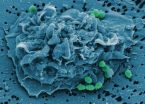(Press-News.org) WASHINGTON, D.C., November 14, 2012—Individuals who do not obtain recommended intake levels of calcium through dietary sources can safely utilize calcium supplements to achieve optimal bone health, an expert panel concludes. These findings appear in the November online edition of Advances in Nutrition, a journal that highlights the significance of recent research in nutrition and illustrates the central role of nutrition in the promotion of health and prevention of disease.
Responding to questions raised last year about a possible link between calcium supplements and a potential increased risk of cardiovascular disease, an expert panel composed of academic and industry experts in the fields of nutrition, cardiology, epidemiology, bone health, and integrative medicine convened on November 10 and 11, 2011 in Washington, D.C.
The panel collected and examined the available body of scientific literature, including randomized controlled trials (RCTs) and observational data, assessing whether long-term use of calcium supplements could promote the occurrence of strokes, coronary heart disease, heart attacks and other forms of cardiovascular disease, and cross-referenced these findings with four of the Bradford-Hill criteria for causal interference: strength, consistency, dose-response and biological plausibility. The panel concluded that the available science does not suggest an increased risk for cardiovascular disease from calcium supplement use.
"There is a strong body of evidence from a variety of rigorous scientific studies reinforcing the benefits of calcium in promoting bone growth and maintenance. After reviewing the entire scope of scientific literature for calcium, we are now more confident than ever in both its health benefits and safety," said panelist Robert P. Heaney, M.D., Osteoporosis Research Center, Creighton University Medical Center. "Consumers can feel confident about the safety of their calcium supplements and should continue taking them with confidence. They should, however, be aware of how much calcium their diets provide, and then supplement accordingly."
In addition to Dr. Heaney, panel experts included: Stephen Kopecky, M.D., Division of Cardiovascular Diseases, Mayo Clinic; Kevin Maki, Ph.D., Provident-Biofortis; John Hathcock, Ph.D., former senior vice president, scientific and international affairs, Council for Responsible Nutrition (CRN); Douglas MacKay, N.D., vice president, scientific and regulatory affairs, CRN; and Taylor Wallace, Ph.D., senior director, scientific and regulatory affairs, CRN.
The CRN Foundation, the educational non-profit affiliate for CRN, the dietary supplement industry's leading trade association, commissioned the panel after results from a meta-analysis of RCTs, and reanalysis of the Women's Health Initiative by researchers at a New Zealand laboratory, prompted concern about a potential association between calcium supplement use and a small increase in risk for adverse cardiovascular events. However, a number of issues with the meta-analysis and accompanying studies—such as exclusion of the majority of RCTs which indicate calcium has no effect on the cardiovascular system; large reliance on unpublished data; failure to appropriately ascertain cardiovascular events; and a lack of information on known cardiovascular risk determinants—warranted a complete examination of the scientific literature. The CRN Foundation assembled the expert panel to study the findings of this analysis in context with the larger body of scientific research on calcium.
"In light of our safety findings combined with the well-documented benefits of calcium, we urge physicians to continue recommending calcium supplements to their patients as appropriate, as our review of the scientific literature further reinforces the valuable role of calcium in helping consumers maintain bone health," said the Mayo Clinic's Dr. Kopecky. "Building and maintaining calcium is vital for all age groups—young children to adolescents to adults and the elderly must obtain adequate amounts of calcium, either through diet or supplementation. For those who are unsure if they need to supplement their diets with additional calcium, make sure to discuss your current nutritional picture with your physician."
Supporting the expert panel's conclusion is the recent "Framingham Study," published online in the Nov. 7 American Journal of Clinical Nutrition by Elizabeth Samelson, Ph.D., et al., which also looked at the association of calcium and coronary artery calcification and found that "…calcium intake from diet and supplements appeared to neither increase nor decrease vascular calcification, which is a measure of cardiovascular risk…The use of calcium supplements is important for many older adults to ensure adequate intake for bone health."[1]
The Institute of Medicine currently suggests women ages 19 through 50 and men up to 71 obtain a Recommended Dietary Allowance (RDA) of 1,000 milligrams calcium daily; women over 50 and men 71 and older should obtain 1,200 milligrams daily to ensure they are meeting their daily needs for strong, healthy bones. Calcium is popular among U.S. consumers, and according to CRN's most recent survey of U.S. adults, 17 percent indicate they take a calcium supplement.
###
The Council for Responsible Nutrition (CRN), founded in 1973, is a Washington, D.C.-based trade association representing dietary supplement manufacturers and ingredient suppliers. In addition to complying with a host of federal and state regulations governing dietary supplements in the areas of manufacturing, marketing, quality control and safety, our 75+ manufacturer and supplier members also agree to adhere to additional voluntary guidelines as well as CRN's Code of Ethics. Visit www.crnusa.org.
The CRN Foundation was established in 2009 as a non-profit 501(c)(3) organization for the purpose of educating people about the beneficial, safe and responsible use of dietary supplements and their ingredients as part of a culture of wellness.
[1] Samelson, E.J., Booth, S.L., Fox, C.S., et al. (2012). Calcium intake is not associated with increased coronary artery calcification: the Framingham Study1. Am J Clin Nutr, 96(5), 1-7.
Calcium supplements remain a valuable tool for maintaining bone health
Expert panel confirms safety of calcium supplements in relation to cardiovascular disease
2012-11-15
ELSE PRESS RELEASES FROM THIS DATE:
Transporting hypothermia victims to advanced heart and lung care facilities 'worth the trip'
2012-11-15
Hypothermia victims whose hearts have stopped functioning should be transported to a medical facility with advanced heart and lung support equipment, even if that means longer travel time, according to a new study by a University of British Columbia medical resident.
In a study published today in the New England Journal of Medicine, UBC medical resident Dr. Doug Brown and collaborators from Banff, Austria and Italy reviewed the medical literature and concluded that two aspects of the European approach to hypothermia rescue – rewarming and transport –should be adapted ...
'Cloning' could make structurally pure nanotubes for nanoelectronics
2012-11-15
Researchers from the University of Southern California (USC) and the National Institute of Standards and Technology (NIST) have demonstrated a technique for growing virtually pure samples of single-wall carbon nanotubes (SWCNTs) with identical structures, a process they liken to "cloning" the nanotubes.* If it can be suitably scaled up, their approach could solve an important materials problem in nanoelectronics: producing carbon nanotubes of a specific structure to order.
Single-wall carbon nanotubes are hollow cylinders of carbon atoms bound together in a hexagonal ...
NIST study suggests carbon nanotubes may protect DNA from oxidation
2012-11-15
Researchers at the National Institute of Standards and Technology (NIST) have provided evidence in the laboratory that single-wall carbon nanotubes (SWCNTs) may help protect DNA molecules from damage by oxidation. In nature, oxidation is a common chemical process in which a reactive chemical removes electrons from DNA and may increase the chance for mutations in cells. More studies are needed to see if the in vitro protective effect of nanotubes reported in the laboratory also occurs in vivo, that is, within a living organism.
"Our findings don't tell us whether carbon ...
Chronic fatigue syndrome -- a system under stress
2012-11-15
Australian researchers have discovered for the first time that reduced heart rate variability – or changes in heart beat timing – best predicts cognitive disturbances, such as concentration difficulties commonly reported by people with chronic fatigue syndrome (CFS). This adds to the growing body of evidence linking autonomic nervous system imbalance to symptoms of this poorly understood disorder.
The findings are reported in the journal PLOS ONE.
Chronic fatigue syndrome is characterised by medically unexplained, disabling fatigue and neuropsychiatric symptoms of ...
Flame retardants linked to neurodevelopmental delays in children
2012-11-15
Berkeley — Prenatal and childhood exposure to flame retardant compounds are linked to poorer attention, fine motor coordination and IQ in school-aged children, a finding by researchers at the University of California, Berkeley, that adds to growing health concerns over a chemical prevalent in U.S. households.
The new study, to be published in the Nov. 15 issue of the journal Environmental Health Perspectives, focuses on PBDEs, or polybrominated diphenyl ethers, a class of persistent, endocrine-disrupting compounds widely found in foam furniture, electronics, carpets, ...
At least one-third of marine species remain undescribed
2012-11-15
At least one-third of the species that inhabit the world's oceans may remain completely unknown to science. That's despite the fact that more species have been described in the last decade than in any previous one, according to a report published online on November 15 in the Cell Press publication Current Biology that details the first comprehensive register of marine species of the world—a massive collaborative undertaking by hundreds of experts around the globe.
The researchers estimate that the ocean may be home to as many as one million species in all—likely not more. ...
Surprising genetic link between kidney defects and neurodevelopmental disorders in kids
2012-11-15
New York, NY (November 15, 2012) — About 10 percent of kids born with kidney defects have large alterations in their genomes known to be linked with neurodevelopmental delay and mental illness, a new study by Columbia University Medical Center (CUMC) researchers has shown.
The study was published today in the online edition of the American Journal of Human Genetics.
Congenital defects of the kidney and urinary tract account for nearly 25 percent of all birth defects in the US and are present in about 1 in every 200 births. Eventually, an evaluation for genomic alterations ...
Appetite suppressant for scavenger cells
2012-11-15
This press release is available in German.
When infected with influenza, the body becomes an easy target for bacteria. The flu virus alters the host's immune system and compromises its capacity to effectively fight off bacterial infections. Now, a team of immunologists at the Helmholtz Centre for Infection Research (HZI) and cooperation partners has discovered that an immune system molecule called TLR7 is partly to blame. The molecule recognizes the viral genome – and then signals scavenger cells of the immune system to ingest fewer bacteria. The researchers published ...
This is your brain on freestyle rap
2012-11-15
Researchers in the voice, speech, and language branch of the National Institute on Deafness and Other Communication Disorders (NIDCD) at the National Institutes of Health (NIH) have used functional magnetic resonance imaging to study the brain activity of rappers when they are "freestyling" – spontaneously improvising lyrics in real time. The findings, published online in the November 15 issue of the journal Scientific Reports, reveal that this form of vocal improvisation is associated with a unique functional reallocation of brain activity in the prefrontal cortex and ...
About one million species inhabit the ocean
2012-11-15
Every taxonomist has calculated the number of existing species within their specialty and estimated the number that remain to be discovered, both through statistical models as based on the experience of each expert. According to Enrique Macpherson, researcher at the Center for Advanced Studies of Blanes (CEAB-CSIC, Spain), who has participated in the study: "Bringing together the leading taxonomists around the world to pool their information has been the great merit of this research".
The statistical prediction is based on the rate of description for new species in recent ...
LAST 30 PRESS RELEASES:
Scalable and healable gradient textiles for multi‑scenario radiative cooling via bicomponent blow spinning
Research shows informed traders never let a good climate crisis go to waste
Intelligent XGBoost framework enhances asphalt pavement skid resistance assessment
Dual-function biomaterials for postoperative osteosarcoma: Tumor suppression and bone regeneration
New framework reveals where transport emissions concentrate in Singapore
NTP-enhanced lattice oxygen activation in Ce-Co catalysts for low-temperature soot combustion
Synergistic interface engineering in Cu-Zn-Ce catalysts for efficient CO2 hydrogenation to methanol
COVID-19 leaves a lasting mark on the human brain
Scientists use ultrasound to soften and treat cancer tumors without damaging healthy tissue
Community swimming program for Black youth boosts skills, sense of belonging, study finds
Specific depressive symptoms in midlife linked to increased dementia risk
An ‘illuminating’ design sheds light on cholesterol
Who is more likely to get long COVID?
Study showcases resilience and rapid growth of “living rocks”
Naval Research Lab diver earns Office of Naval Research 2025 Sailor of the Year
New Mayo-led study establishes practical definition for rapidly progressive dementia
Fossil fuel industry’s “climate false solutions” reinforce its power and aggravate environmental injustice
Researchers reveal bias in a widely used measure of algorithm performance
Alcohol causes cancer. A study from IOCB Prague confirms damage to DNA and shows how cells defend against it
Hidden viruses in wastewater treatment may shape public health risks, study finds
Unlock the power of nature: how biomass can transform climate mitigation
Biochar reshapes hidden soil microbes that capture carbon dioxide in farmland
Reducing saturated fat intake shows mortality benefit, but only in high-risk individuals
Manta rays create mobile ecosystems, study finds
Study: Mixed results in using lipoic acid to treat progressive multiple sclerosis
Norbert Holtkamp appointed director of Fermi National Accelerator Laboratory
New agentic AI platform accelerates advanced optics design
Biologists discover neurons use physical signals — not electricity — to stabilize communication
Researchers discover that a hormone can access the brain by hitchhiking
University of Oklahoma researcher awarded funding to pursue AI-powered material design
[Press-News.org] Calcium supplements remain a valuable tool for maintaining bone healthExpert panel confirms safety of calcium supplements in relation to cardiovascular disease



